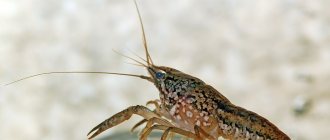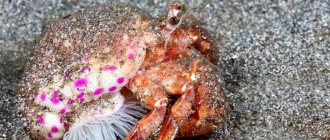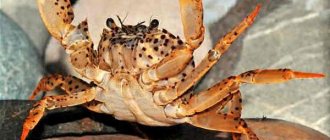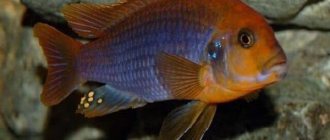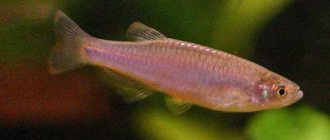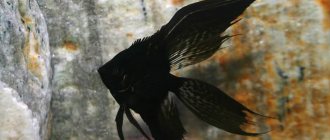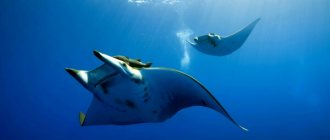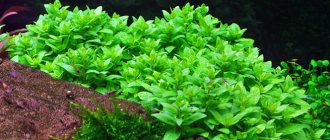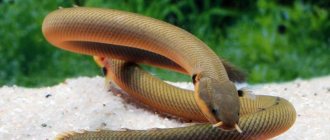Description of the species
Thanks to its original appearance, the Australian crayfish has become a regular in decorative aquariums, and its tender meat and rapid growth have made it a profitable breeding object. Let's find out what this inhabitant of the southern waters looks like and what features it has.
Appearance
The second name for the red claw crayfish is Yabby Red Claw. But the main color of this cancer is blue. Among the predominant shades are green, brown, blue, orange, and red. There are yellow spots on the shell.
The brightness of the color of the Australian crayfish is directly related to the hardness of the water. The higher the indicator, the brighter the arthropod’s shell. In soft water, the shell of the crayfish turns pale.
Characteristics of the Australian crayfish:
- length – up to 20 cm
- weight – up to 0.4-0.5 kg;
- lifespan – 5 years.
Character and behavior
Australian crayfish are non-aggressive. But their behavior is significantly influenced by their habitat. Under certain circumstances, arthropods begin to show hostility.
Peculiarities of behavior of red claw crayfish:
- get along well with all types of fish, agree to share homes with them;
- often conflict with each other;
- Cannibalism is possible.
In nature, red-clawed crayfish use their claws to dig holes for shelter. They also hide under snags and between the roots of coastal plants. They go hunting at night and prefer to sleep during the day. If crayfish go for a walk in the daytime, it means they are in the molting period.
In nature, Australian crayfish eats:
- detritus;
- worms;
- snails;
- small fish.
Detritus is dead organic matter consisting of the remains of invertebrate animals and temporarily excluded from the cycle of biological nutrients.
Sexual characteristics
The readiness of males for mating is indicated by a flat thickening on the outer sides of the claws. It can be white, pink, but more often – red. According to these o, in honor of which the Australian crayfish received its second name, males are easily distinguished from females.
Females have neat claws, without protrusions. Males are slightly larger in size than females.
Reproduction
When breeding, the ratio of males to females ranges from 1:1 to 1:4. Sexual activity, the duration of the incubation period and the growth rate of juveniles are influenced by water temperature. The optimal value for spawning and egg development is +25…+28 °C.
The recommended ratio of dark and light time is 12/12 or 10/14 hours. For breeding, ponds are used in which it is easy to manage the broodstock. The density of crayfish is 1.5 thousand per 1 hectare.
The largest and strongest individuals are chosen to play the role of producers. The fertility of one female weighing 100 g is 1 thousand crustaceans. Optimal parameters of the mother pond:
- area – 1,000 sq. m;
- depth – 1.2-2.5 m;
- bottom profile – V-shaped.
The duration of gestation of eggs and larvae in a female Australian crayfish is 8-9 weeks.
Meat yield
Australian crayfish are raised for meat. The business is profitable due to low investments and rapid growth of arthropods. Biological and fish farming indicators:
- commodity weight of one copy – 200-400 g;
- weight gain – 50-60 g in six months;
- the amount of meat in the tail is 30% (in other crayfish - no more than 20%).
When industrially growing red claw crayfish in the southern regions of Russia, it is possible to grow individuals weighing 200 g or more in 4 months. Common crayfish reach a weight of 100-120 g in 10 years of life.
Taste of meat
Australian crayfish differ significantly in taste from their domestic river counterparts. Their meat has a special texture; it is more tender, with large fibers. Experts say that the meat of red claw crayfish resembles lobster in structure and crab in taste.
Australian crayfish meat goes harmoniously with different ingredients. In restaurants, it is usually served in combination with various river delicacies or sauces that enhance the taste of the meat, which is prepared using the same technology as lobster.
The meat of the Australian red claw crayfish is dietary; it is recommended for people with diseased blood vessels and circulatory disorders. 100 g of meat – 80 kcal.
The Rise and Fall of Red Claw Crayfish Aquaculture in Ecuador
Red claw crayfish (Cherax quadricarinatus) ready to eat Presented by a perspective from Xavier Romero ( [email protected] ), a biologist who, as a small farmer and researcher, was actively involved in establishing red claw crayfish farms in Ecuador (1995-1996). His doctoral dissertation focused on diseases of red claw crayfish, especially on farms in Ecuador. The report was published in 2001 in the journal World Aquaculture.
Content
Start
Most people prefer to listen or read about success stories in aquaculture, but it is only through experience and personal involvement that we understand how to improve and avoid repeating mistakes over and over again. This article is not about a success story, but rather offers some useful lessons about how the forecast does not always live up to expectations. I hope it will help other investors and farmers avoid similar troubles in the future.
In 1994-95, a new species of freshwater crustacean, the Australian red-claw crayfish (Cherax quadricarinatus), was proposed for cultivation in Ecuador. It seemed potentially interesting to grow. Expected prices based on previous reports ranged from US$10 to US$14 per kg for whole fish over 60g. The new industry received much attention and investors eventually decided to develop farms in the coastal provinces of Ecuador, with most farms located in the province of Guayas.
All is ready
It seemed that all the ingredients for success were present. The fundamental biology of Cherax quadricarinatus has already been studied in detail, and the species itself has taken root well in other tropical zones. They had information about production volumes in its native habitat and in other countries where it began to be grown.
We launched production in Ecuador, the volumes were very encouraging. Two companies, INACUA and NAVIMAR, have published brochures to promote and advertise cancer culture based on semi-intensive and intensive culture technology. An important factor was the final purchase price. The minimum price stated in the brochures was about US$8 per kg, with the prospect of increasing to US$12 per kg depending on market developments. The purchase price could have increased even more if the product had been introduced to traditional markets, for example, in Northern Europe. This seemed logical to potential producers, since native European crayfish populations had been decimated by a "plague" caused by the fungus Aphanomyces astaci, and theoretically there was a significant vacuum in the market waiting to be filled.
Safe business?
Thus, it seemed that the international market was completely open to the red claw crayfish. In this regard, in 1996 and 1997, Ecuadorian banks issued loans for the construction of farms. Even in the unpredictable world of agribusiness, given the success of Ecuador's shrimp industry, red claw crayfish farming seemed like a "safe business." By the end of 1997, more than 300 hectares of farm ponds had been financed and built. Typically, each farm had an area of about 10 hectares, divided into ponds of 0.25 to 0.5 hectares. Depending on the production technology and the price of planting material, the cost of creating a farm for breeding red claw crayfish, stated in the brochure, was about 50 thousand US dollars per hectare. Thus, a conservative estimate of the total investment in the new industry was approximately US$15 million.
| Table 1. Change in price for juvenile red claw crayfish from January 1995 to July 1997 ($US/piece) | |||||||
| Provider | January95 | June95 | January96 | June96 | September96 | June97 | July97 |
| A | 0.80 | 0.60 | 0.40 | 0.40 | 0.40 | 0.35 | 0.35 |
| B | 0.20 | 0.20 | 0.20 | 0.15 | 0.15 | 0.15 | |
| C | 0.25 | 0.20 | 0.15 | 0.12 | 0.12 | ||
| D | 0.12 | 0.10 | 0.08 | ||||
By early 1998, many farmers had completed their first full production cycle and had product to sell. And then the realities and prices of the seafood market became obvious. Ecuador has a long tradition of exporting quality seafood and its exporters have established relationships with distributors and wholesalers throughout the world. Thus, the failure of the developed scenario for red claw crayfish could not be associated with the seafood marketing system. The problem was that manufacturers had high expectations regarding the price of their products. Marketing seafood, which is the majority of consumer demand, is relatively simple when priced correctly, but can become a nightmare if priced incorrectly as the product quickly becomes a liability. This is exactly what many red claw crayfish farmers in Ecuador have encountered. Due to the harsh reality of the agricultural economy, several farms have gone out of business, including NAVIMAR, which was one of the main inspirations for the idea. The actual purchase price for red claw crayfish weighing more than 60 g in 1998 ranged from 2.6 to 3.5 US dollars per kilogram. It was possible to find some small niche markets that were willing to pay slightly higher prices, but these markets quickly became saturated. As a result, all farmers had to sell their products at prices up to 40% lower than predicted and significantly less than production costs.
| Table 2. Comparison of predicted and actual farm production and income data. | ||||||||||
| Result | Planting density (pcs./m2) | Survival rate (%) | Average weight (g) | Individuals >60g (%) | kg/ha (>60g) | Price (US$/kg) | Revenue ((US$/kg)) | Harvest per year | Total income | |
Intensive type system | Forecast | 7 | 70 | 100 | 100 | 4900 | 8.00 | 39200 | 2 | 78400 |
| Actually | 7 | 60 | 55 | 45 | 1050 | 3.52 | 3659 | 2 | 7318 | |
Semi-intensive system | Forecast | 4 | 80 | 60 | 100 | 1920 | 11.00 | 21120 | 2 | 42240 |
| Actually | 4 | 60 | 65 | 50 | 780 | 3.52 | 2745 | 2 | 5490 | |
Small chances
Several farmers have formed a producers' association called LANECUA. They held meetings and tried to develop new marketing strategies, but it soon became obvious that it was simply impossible to achieve the original price on which all financial calculations were based. Despite their attempts to reduce production costs by reducing the number of employees, improving feed conversion ratios and saving energy, debt repayment terms proved difficult to meet.
The market price of products was not the only calculation error that red claw crayfish producers encountered. From a commercial point of view, it is clear that the average growth rates of intensively farmed individuals are significantly lower than the growth rates obtained from pilot tests or scientific experiments. In fact, they were much lower than reported. Like other species of crayfish, the growth rate of red claws depends on the stocking density. For example, farmers soon discovered that at a stocking density of seven crayfish per m2, growth rates were so slow that within seven months only a small percentage of individuals reached the required commercial size of more than 60 g. Difficulties associated with growth rates depending on density and distribution mass on commercial farms are described in the previous edition of World Aquaculture.
Most farmers have avoided serious disease problems. Although some pathogenic organisms similar to those found in crayfish in Australia have been found, with the exception of rickettsia-type organisms (RLOs), which are a major cause of mortality, few have resulted in significant disease outbreaks in commercial ponds.
The economic scenario that was offered to farmers assumed the production of highly commercial red claw crayfish (more than 60 grams) in a volume of 4500 kg per hectare in a six-month cycle. Taking into account two cycles per year and with a selling price of $7.7 per kilogram, the gross income from 10 hectares should have been about $700,000 per year.
The proportion of individuals actually traded (more than 60 grams) was only about 50-60% of the total biomass, and actual production was in the order of 1500-2500 kg/ha. At around $3.50 per kg, even the best-case scenario would bring in $9,000 per hectare for one crop, or $180,000 per year from a 10ha farm. The gap between hope and reality was too big to bridge.
As crayfish farms began to close, local media reported on the difficulties farmers faced in finding markets for their product. Most farmers, including myself, simply could not believe that the estimated prices were so wrong and the huge difference that existed between the forecast and reality.
The final chapter
The events of the final chapter, dedicated to the breeding of red claw crayfish in Ecuador, may unfold in the near future. The only farm still in operation producing red claw crayfish is at the center of some new "mainland shrimp farming" scheme. But most likely, Darwin's theory of evolution will turn this farm into another mainland shrimp farm, and then eventually the last red claw crayfish farmer in Ecuador will disappear.
At a recent aquaculture conference in Guayaquil, some of the discussion focused on turning all red claw crayfish farms into mainland shrimp farms. However, red claw crayfish as a seafood is here to stay. Wild crayfish can now be caught in flooded areas near former farms, and their population has settled behind the Chongon Dam in Guayas province. Since 1997, fishermen have been constantly catching red claw crayfish and selling them to passersby.
Causes of collapse
The reasons why this promising industry for Ecuador has failed is largely due to a combination of the same general reasons that have thwarted many other promising aquaculture ventures.
These include:
- Excessive expectations of the future market, the belief that any market will expand to absorb new products as they become available.
— Excessive capitalization of the industry, financial planning based on unprofessional data on purchase prices for species about which little is known.
— Excessive optimism among farmers, use of unrealistic data on production rates and production costs in Ecuador, and use of data from other geographic areas without pilot testing.
— Excessive promotion by officials and people with vested interests who created the “boom” by irresponsibly exaggerating expectations and financial benefits and hiding numerous difficulties.
The main objective of future investors in red claw crayfish farming anywhere is to avoid the temptation to finance production based on prices and production rates in other parts of the world. For example, at home in Australia, the production of red claw crayfish in 1994-1995 was 62.3 tons, and the purchase price was almost $8 per kg. And while there are reports from Australia of prices as high as A$20 per kg, or US$15, in some overseas markets, these are clearly rare occurrences. Additionally, it is now apparent that seafood reports regarding red claw crayfish are much more cautious; they often cite a lack of price history in the market, making price prediction difficult.
Useful lesson
Obviously, there is a lesson to be learned from this whole story, especially the part in which the early promotional articles about red claw crayfish farming in Ecuador made the business so attractive. There may be a market for the red claw crayfish, but at the moment it is a little more niche and only in certain countries. This crustacean seems to be particularly suited to Asian markets, as it can live without water for many days. Its flavor is relatively mild and its texture is delicate when prepared fresh. With proper pricing and reliable supply, as in the United States, Scandinavia and Europe, red claw crayfish can be better represented in seafood markets. That is, the advantages that made the red claw crayfish farming proposition so attractive and created the boom in Ecuador remain. As are the uncertainties regarding price and technical difficulties that cannot be denied.
Therefore, before investing their money and time in any new red claw crayfish farming venture, potential farmers should focus only on a reliable market with a specific demand and scale their production accordingly. Small production will also allow them to increase their market share by increasing their experience. There is always a learning curve to success, and negative experiences can be just as rewarding as positive ones, if not more so. This is especially true for producers in other Latin American countries where red claw crayfish farming is currently developing.
Commercial aquaculture has a long history of large investments in "high value" species and "package production" enterprises, all of which resulted in total financial losses. So any aquaculture investment scheme that combines the application of an unproven technology to an extent that has not been previously tested with a theoretical market for the product is a very, very good reason to be cautious, no matter how persuasive the people promoting it are. diagram.
——
Romero, X. 2002. Ups and downs of red claw crayfish farming in Ecuador. World Aquaculture, 33(2):40-46.
Habitats in nature
The habitat of the Australian red-clawed crayfish is stagnant waters in the Australian region. This representative of arthropods is found on the Australian continent and in New Guinea.
Cancer prefers to live in bodies of water where there is no current or minimal current. Habitats:
- ponds;
- shallow rivers;
- lakes;
- streams.
It is living in stagnant water that allows Australian crayfish to be kept in closed reservoirs and aquariums.
Breeding crayfish
Today, Australian crayfish is becoming a promising target for industrial breeding. The growth parameters and other characteristics of red claw crayfish make it possible to create a profitable business in their breeding.
Where are crayfish raised?
For breeding crayfish, a system of shallow ponds is created - incubation, uterine, nursery, feeding. Some ponds are covered with polycarbonate. In them, the temperature in winter does not fall below +7 °C, so that the crayfish do not fall asleep, but feed and increase mass.
Egg females are kept in brood ponds. Nursery ponds are made shallow - 0.5-1.5 m, with an area of 0.1-0.5 hectares. It is advisable that they have a water discharge - a crayfish catcher is installed in it.
Features of arranging a reservoir for growing crayfish:
- the pond is filled with water a couple of weeks before the crayfish are planted;
- the walls in such reservoirs are made vertical;
- the bottom is lined with polypropylene - it does not rot, helping to keep the water clean;
- crushed stone, broken brick, ceramic waste are placed on polypropylene in a layer of 20 cm, and on top - a layer of sand 10 cm thick.
Crayfish are also grown in closed water supply systems, which include:
- crayfish pools;
- water treatment unit;
- bio-filter;
- water treatment unit.
The water temperature in the pools is maintained using split systems.
Artificial burrows made of plastic pipes are installed in crayfish pools. Such shelters help prevent cannibalism.
Neighbors and vegetation
Red claw crayfish can get along with different types of fish, so small non-predatory species can be introduced into ponds. After the crayfish there is a lot of food leftover, and thanks to the small fish that eat them, it is possible to maintain the purity of the water.
Large and predatory fish cannot be bred in ponds with crayfish, as they can eat small crustaceans.
The flora of the ponds is standard. Cancers love plant foods. The more plants in the pond, the better. Moreover, these arthropods not only eat the leaves, but also damage the roots when they dig them up.
Requirements for the reservoir
Australian crayfish are undemanding to water quality, so there are no special problems when creating crayfish breeding ponds.
Optimal conditions of detention:
- active reaction – in the pH range 6.5-8.5;
- hardness – from 5 to 20;
- temperature – +20….+28 °С;
- minimum / maximum permissible temperature –10 / 36 °C.
Crayfish, unlike shrimp, are able to survive in the most unfavorable conditions - with low oxygen levels and high concentrations of nitrates. Copper ions are the most dangerous for crayfish.
Feeding regimen and diet
In nature, crayfish eat everything that comes their way. Their diet during artificial breeding should be varied, complete, and rich in proteins. Compound feeds help solve the nutrition problem. Feed crayfish 2-3 times a day.
Compound feed, chalk, proteins, bloodworms, and earthworms are added to regular food. Before adding a new portion of food, check whether the feeders are empty.
The diet of young animals should include:
- snails;
- larvae;
- Daphnia;
- cyclops;
- aquatic worms;
- fish fry.
Young crayfish willingly eat minced meat. As they develop, the diet becomes more varied. To prevent crayfish from eating each other, meat, fish, vegetables, bread, cake and even frogs are introduced into their diet.
The daily feed rate is 2% of the arthropod’s body weight, for spawning females – 4%.
In order for crayfish to grow well, their food must contain a variety of components of plant and animal origin, minerals and vitamins. Today, foreign compound feeds for shrimp help solve the nutrition problem.
The optimal composition of branded food for crayfish:
- proteins – 43%;
- fats – 8%;
- fiber – 4%.
For crayfish, imported industrial granulated feed intended for hydrobionts (fish, mollusks, crustaceans, etc.) is also suitable.
Optimal food ratio:
- vegetable – 70%;
- animal – 30%.
It is recommended to add dry leaves, ground stems, and cane to food. The diet of Australian crayfish must include beech or oak foliage. This dish is not only a delicacy for red-clawed arthropods, but also an antiseptic necessary for their immune system.
What should you not feed?
Although red claw crayfish are considered omnivores, there are foods that are best avoided:
- banana peel;
- grated beets, carrots, potatoes - they spoil the water;
- Crayfish do not eat apples.
It is not recommended to clog crab-breeding pools with minced meat, eggs, cottage cheese, or food scraps unless the water is cleaned and filtered.
Breeding procedures on farms
To create a mini-farm for breeding crayfish, a small plot and minimal costs are enough. The duration of growing crayfish for sale is a year and a half. The investment pays off within a year.
The procedure for artificial breeding:
- In October-November, females are placed in the uterine pool. In June, newborn crustaceans appear and are kept in incubation tanks.
- To ensure the safety of the larvae, in May the eggs are collected and hatched using the Weiss apparatus. One 8 liter incubator holds up to 15,000 eggs.
- After the second moult, the crayfish are transferred to nursery ponds, where they are raised at +22...+24 °C to 8 cm in length and to a weight of 15-18 g.
- Yearlings are transferred to feeding ponds, where they gain a weight of 40-60 g.
Mass production of crayfish requires considerable investment. They prepare a whole system of pools or tanks, climate control and water supply.
Containers for breeding crayfish should be large enough. If the crayfish are crowded in them, they eat each other. Separate tanks are provided for young animals, otherwise they will also be eaten.
You can also learn about the experience of breeding Australian crayfish in the following video:
Compared to many other aquatic organisms, these arthropods are unpretentious, grow very quickly and produce a large yield of valuable meat. Such features of Australian red-clawed crayfish make them a very attractive object for industrial breeding.
0
0
Copy link
A creeping delicacy: how they make money on the Don by breeding Australian crayfish
The problem for many entrepreneurs is the seasonality of their business: during some months they actively earn money, during others they tighten their belts. Entrepreneur Alexander Nikulov is engaged in complex landscaping and for a long time he was looking for a business idea that would bring him income in the winter. And now, after several years of experimentation, he seems to have found such an idea - and launched a farm for breeding Australian crayfish. Founder Alexander Nikulov spoke to the Biz360.ru portal about how to develop a new bioculture for Russia.
Dossier
Alexander Nikulov
, 50 years old, entrepreneur from the Rostov region, founder of the farm. For more than 20 years, he has owned and operated in the city of Volgodonsk, Rostov region, which is engaged in complex landscaping. In 2018, he founded a farm where he grows Australian red claw crayfish.
Why did the cancer grind
I have been a businessman since childhood; I have never worked for hire for a day. Mine has been doing complex landscaping and landscaping for 20 years. We serve both private clients and municipalities. We have our own plant nursery and two garden centers - in Volgodonsk and Rostov-on-Don.
The problem is that this business is seasonal. And I have long been looking for a business that would bring me income in the winter. I tried to make plastic windows and swimming pools, created furniture production. But there is very high competition in these areas, and these projects also had seasonal failures. Over time they had to be closed.
One day, while looking for a new business, I came across information on the Internet about the Australian red-clawed crayfish. It “hooked” me by the fact that it contains twice as much meat as ordinary crayfish. Australian crayfish are similar in taste and texture to shrimp and lobster and, in a sense, can be their substitutes. Their meat is denser and at the same time more tender than that of Don crayfish.
Almost everyone in Rostov and the region understands crayfish: where to catch them, who to buy them from, how to use them. But the problem is that we have fewer and fewer crayfish. The main reason is uncontrolled fishing by numerous poachers. Previously, we caught crayfish with our hands - and we didn’t take anything smaller than the size of our palm. Now they are sold the size of a finger - that is, the crayfish are simply not allowed to grow and reproduce.
There is one more problem. Restaurants and stores are afraid to take crayfish because almost all sellers have problems with documents, because... Most crayfish are caught informally. If we are talking about “natural” crayfish, you need to take a quota, and this is generally a separate complicated story.
Creating a farm
I started by contacting the Astrakhan Institute of Fisheries, Biology and Environmental Management, where they have been studying Australian crayfish for a long time. They brought it to our country 10 years ago and developed a technology for growing it. It turned out that in the conditions of the south of Russia it takes root well.
At this institute I received breeding technology, in addition, we were given a business plan based on the calculation that every year we would produce 10 tons of crayfish. We carefully worked through this plan, trying to understand how best to organize everything. We watched YouTube - there is quite a lot of information on this issue. If I take on something, I plunge headlong into the topic and study everything myself. Preparations for the launch took about six months.
First, we bought a building in Volgodonsk, where we built a closed water supply system for breeding crayfish fry. The first year we bought a fry and raised it. And then they left a small breeding stock and started breeding crayfish themselves. Having your own breeding stock turned out to be more profitable than purchasing new fry every year.
There were no problems with obtaining the necessary certificates and other documents. I must say that the inspection authorities were very surprised by our project. When we came to the veterinary control service, they didn’t even believe it: “Come on, are you going to breed crayfish?!” We brought their representatives to the farm, showed everything, they conducted research and issued a veterinary certificate. An examination to determine the absence of diseases in crayfish was done in a laboratory in Rostov-on-Don. Then we made samples of frozen products and also received a certificate for them.
We raised our first small batch of crayfish in 2021. This year we received approximately 2 tons of crayfish. This is very little: to gain profit, you need to earn at least 10 tons. Therefore, we did not sell approximately half of this year’s “catch”, but left it for further breeding. For now we are working for the future.
Farming is an expensive business
The total amount of investment in launching the cancer farm is about 20 million rubles of own funds, no borrowings were involved. They went towards the purchase and decoration of premises, the purchase of equipment, the construction of ponds, and personnel training.
At the start, I had no idea that so much investment would be required. It would seem that what’s wrong with building ponds? He hired a tractor, he dug holes - and that’s it. But in fact, the ponds cost me about a million rubles for each hectare. The problem was that I had no experience in this area. And in the process, a lot of nuances began to creep out.
To bring the farm into profit, large financial investments are needed. We have completed one farm, and next year we will build another. We need new ponds, swimming pools, technologies, people. I don’t have my own money in the amount necessary for this, so now I have to use borrowed funds.
For lending, we cooperate with Center-Invest Bank - we are its long-time clients. The Rostov Regional Agency for Entrepreneurship Support also helps us. It gave us a loan of 5 million rubles at preferential interest for 5 years.
The crayfish menu includes bloodworms and oatmeal
The main part of the Rostov Lobster farm is closed water supply installations. We made and adjusted them ourselves, based on what we saw in Astrakhan. We also studied information on the Internet regarding this matter. We make our own pools from polypropylene. These are welded bathtubs 25 cm high, which stand in three tiers. We have modernized the design of the bathtub so that it can be soldered faster.
All our pools are provided with filtered water. A closed water supply system involves constant filtration and oxygen enrichment. In our pools, the water is renewed three times per hour. It is passed through a biofilter - this is how aeration and cleaning occurs.
Over time, we gain more and more knowledge and experience. So, we are already developing food to make crayfish grow faster. We are modernizing their maintenance technology, installations, and ponds. We made the same bathtubs that everyone produces square, oval. This way, dirt does not linger in the corners and nothing prevents water from circulating.
In winter, crayfish are grown in closed water supply systems. The breeding stock begins to produce eggs in December, and fry appear in January-February. They grow at a temperature of 28-29 degrees, in the first month they grow up to 3 cm, in the second - up to 5 cm in length.
Until May, we raise fry in installations, and in mid-May we release them into special ponds with an area of 1-2 hectares. We fill it with the purest natural water from the irrigation canal, which is laid from the Tsimlyansk reservoir. In ponds, crayfish, under favorable conditions, gain weight by about 1 gram per day. We begin catching grown crayfish in mid-August. By the end of August, some individuals reach a weight of 100 grams.
We feed the fry three to five times a day with natural bloodworms, oatmeal and grains. In the summer we give ground crucian carp. We have developed our own compound feed with the addition of fishmeal. Plus, in the ponds, the fry eat spider bugs.
In general, our crayfish grow on an environmentally friendly product. People sometimes write to us on Instagram that we “feed crayfish with antibiotics, that’s why they grow so fast.” But the Australian crayfish is quite capricious, and it simply will not eat any nonsense.
Live crayfish are transported without water. We sent them to Moscow by bus in a thermal box. Out of a 5 kg batch, only five crayfish did not arrive. But the Australian crayfish does not produce putrefactive bacteria for about a day after death; such crayfish can also be boiled.
Demand exceeds supply
An ordinary Don crayfish costs 600-800 rubles per kilogram. At the same time, individuals weighing 40-60 grams are considered large. We sold our crayfish of the same size during the season for 1,200 rubles per kilogram, now we sell for 1,500 rubles. But Australian crayfish has twice as much meat as Don crayfish. So, in terms of meat, there is almost no difference in price. In our crayfish, 25% of the weight is the weight of the meat in the tail and neck: what people mainly eat.
The largest crayfish from our production weigh 150 grams. Of these, the weight of meat in the neck was 38 grams. With my weight of 110 kg, I ate three of these crayfish and didn’t want any more. That's over 100 grams of pure protein! In fact, these are not “beer crayfish” that can be eaten like seeds, but rather an elite product. It is more designed for family consumption with a glass of good wine. It’s not called the “freshwater lobster” for nothing.
Despite the relatively high price, we have no problems with sales. The last two “harvests” were gone literally instantly, according to an ad on Avito. And this year we sold out a ton of product in a month - by the beginning of November there was no more than 100 kg left. Those who try our crayfish usually become regular customers.
There's only one problem. Sometimes people don't even look at what kind of cancer we sell. We write: "Australian red-clawed crayfish." And people call, ask the price and call us crazy: “Everyone has half the price! It’s not enough that yours is “Australian” - cancer is cancer!” We still need to work for more than one year for people to understand what it is. But in any case, demand exceeds our production volumes.
Buyers from other regions contact us themselves. People have already contacted us from Sochi, Volgograd, St. Petersburg, and Moscow. While I have to refuse everyone, we have already sold everything. Potential buyers include restaurants and a supermarket chain. But to work with them, you need volumes. We plan to start cooperation in 2021.
Defeat cannibalism
The Australian crayfish is a problematic creature to breed. The main difficulty is that in pools with fry you must always maintain the temperature and oxygen supply. If the power goes out as a result of an accident, the entire fry may die due to lack of oxygen within an hour. You can work all winter, grow several tens of thousands of crustaceans - and lose them all in just an hour. To prevent this from happening, we installed automatic emergency generators in the first year.
Most of the other difficulties are also related to the characteristics of Australian crayfish. They are cannibals and can easily devour their molting “comrades.”
The fact is that within two to three hours after shedding its shell, the cancer is soft and defenseless. You can see them right away - they lie on their sides, barely alive. And so that they are not eaten by their own relatives, they need to be transplanted into another pool, and only after a few hours released into the general pool again. It turns out that they need to be monitored around the clock.
Another way to prevent cannibalism is to feed growing crayfish well. But, as it turned out, here, too, you can go too far. This year, at one point we realized that we had overfed our crayfish. They were so stuffed with meat that when they moulted they could not shed their shells.
Frozen crayfish
In the first two years we only sold live crayfish. Now we are working on the technology for its conservation. We freeze crayfish in vacuum packaging using the blast freezing method - at -50° for one and a half hours.
Before use, it must be defrosted for an hour and a half under cold running water. And the resulting product is almost indistinguishable in quality from fresh crayfish.
I came up with the technology for blast freezing in vacuum packaging myself - no one does this in our country. Frozen foods usually taste worse because they lose moisture. And with our shock freezing in a vacuum, all the moisture that was in the product is preserved.
We purchased the necessary equipment for packaging, tested the technology, passed certification - and are now ready to increase production volumes. In between feeding the fry, our employees freeze the “ready” crayfish.
Personnel issue
The production team is about ten people, plus a marketing and advertising specialist. The process is supervised by the production manager at the farm and the manager at the pond farm. Accounting is provided by our main one - we simply assigned a separate person to this area.
The staff was found through an ad on Avito. It helped us that the Flora-Service brand has long been known in the region on the labor market. We pay wages weekly - this is convenient for both the staff and me; if necessary, you can punish a person with a ruble if he does not work well.
We have trained and continue to train employees. Industrial breeding of crayfish is a new business for our country. Finding an ichthyologist on crustaceans in Russia is almost impossible. Therefore, we have to learn and improve ourselves.
What's next
At the moment, we are the only farm in Russia that is entering the industrial production of Australian crayfish. Besides ours, there is another large farm near Astrakhan. But their main specialty is fish: as far as I understand, crayfish are not their priority.
The pandemic has not affected our businesses in any way. We work as usual: there is no quarantine, no sick people. New ponds, buildings, and water supply systems are being built. Now we are honing technologies, including those for processing and storing products. We are also developing the technology for boiling and preserving crayfish in 0.7 liter glass jars. We will build a processing plant.
Our goal for 2021 is to reach a production volume of 10 tons of product. This will allow us to finish the year with a profit. Every next year we will grow by 10 tons. Within 5 years we plan to reach a productivity of 45 tons per year.
This spring we won the “Business Success” competition in the “Best Agricultural Project” category. I hope that we will take one of the prizes at the All-Russian final. Then we will be noticed, and, hopefully, we will be able to count on grant support.
At the World Food exhibition in September this year, we won the gold medal “Product of the Year 2020” in the “Fish and Seafood” category. Now we have the right to place information about this on our products, which is good for marketing and promotion. When exhibitions open again, we plan to actively participate in them. We will have a separate stand with live crayfish - I already know how to make it. When big crayfish crawl before your eyes, it's impressive.
In order not to miss an interesting and useful article about small business for you, subscribe to ours, and.
biz360
